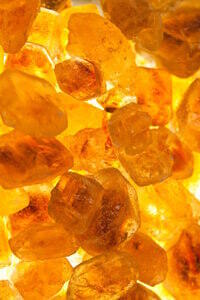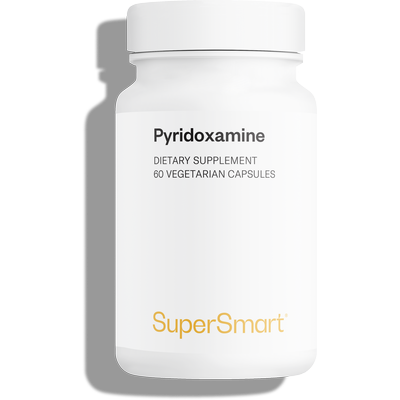03-10-2016
Pyridoxamine, an AGE-formation inhibitor
 A number of studies have shown that pyridoxamine is an effective inhibitor of the formation of Advanced Glycation Endproducts (AGEs) and that it helps delay the development of certain complications of diabetes .
A number of studies have shown that pyridoxamine is an effective inhibitor of the formation of Advanced Glycation Endproducts (AGEs) and that it helps delay the development of certain complications of diabetes .
Pyridoxamine is one of three natural forms of vitamin B6, the other two being pyridoxine and pyridoxal. All three differ with respect to their substituent at the 4-position of their nucleus. In the case of pyridoxamine, it is a CH2-NH2 substituent, an amine group. The three forms can be converted into pyridoxal phosphate, the active form of vitamin B6.
The glycation process
Glycation is a non-enzymatic reaction which takes place between proteins and sugars and irreversibly changes the configuration of proteins.
These altered proteins, called Advanced Glycation Endproducts (AGEs), are no longer able to fulfil their role. AGEs are the starting point of the body’s aging mechanisms as well as of cell metabolism dysfunction. The accelerated formation of these compounds is strongly associated with hyperglycaemia.
The cross-linking of glucose and certain other sugars with proteins was discovered in 1912 by the chemist Louis Camille Maillard. This reaction was first observed while heating food in the presence of sugar. It was only towards the mid-1970s that biologists accepted that these Maillard reactions could also occur within the body.
It was even more recently that their role in certain pathological manifestations common to both diabetes and aging was recognised. In the human body, the sugar-protein complex can initiate a chain reaction which within a few days leads to the formation of reversible intermediate products. These products subsequently dehydrate, condense and form into irreversible compounds, AGEs.
Many AGEs initiate the formation of abnormal cross-links in diabetic patients, an AGE reaction stage which damages proteins and other macromolecules by altering their molecular configuration. Others are able to trigger various damaging responses following absorption by specific cell receptors. These glycation products accumulate in diabetics and older people and are implicated in numerous physiopathological changes.
Cross-links with collagen proteins contribute to tissue rigidity and loss of elasticity, as well as to the thickening of capillary walls observed in diabetes and aging. This alteration of proteins is also involved in the lens opacification that occurs in cataract formation. DNA mutations may originate from the glycation of nucleic acids which alters the replication and transcription capacities of DNA. AGE formation on lipids results in them becoming oxidised, thus promoting the development of atheromatous vascular damage.
Inhibits AGE formation
Pyridoxamine is effective at inhibiting AGE formation from Amadori products. It has been shown to inhibit both AGE formation and the development of diabetes complications in animal models. In vitro, pyridoxamine inhibits the formation of AGE and ALE (Advanced Lipoxidation Endproducts) as well as chemical modification of proteins in animal models of hyperglycaemia and hyperlipidaemia. Unlike other AGE inhibitors, pyridoxamine inhibits the breakdown of Amadori products into AGE.
Two principal mechanisms have been proposed to explain this reduction in AGE formation: in vivo, the trapping of the carbonyl group and the recovery of metal ions. It is suggested that pyridoxamine blocks the conversion of Amadori products into AGE by interfering with the catalytic role of redox metal ions that are required for this glycoxidative reaction. Pyridoxamine’s discoverers recently suggested, on the basis of in vitro studies, that it principally blocks the conversion of Amadori intermediates into AGE-carboxymethyllysine, the inhibitory mechanism interfering with the catalytic role of the redox metal ions essential for the glycoxidation reaction. 1.
An alternative mechanism may be the chemical trapping of the low molecular weight reactive carbonyl groups produced by the breakdown of glucose and lipids.
Inhibits ALE formation
In vitro, pyridoxamine has also been shown to be an effective ALE inhibitor. By analogy with the previously-described mechanism, it is suggested that trapping ALE formation intermediates also occurs during lipid peroxidation reactions.
An ALE inhibitor, in the case of hyperlipidaemia, pyridoxamine reduced levels of cholesterol and triglycerides while preventing chemical modifications and cross-links in renal and vascular collagen in Zucker diabetic fatty rats2. It protected against pathological changes in early diabetic neuropathy induced by injection with AGE-modified serum albumin.
Prevents certain complications of diabetes
Several pre-clinical studies have demonstrated that taking oral pyridoxamine has a protective effect in the prevention of neuropathies in type 1 and 2 diabetics.
A study investigated pyridoxamine’s capacity for protecting against diabetes-induced retinal vascular lesions. Its effect was compared to that of the antioxidants, vitamin E and R-alpha-lipoic acid, in rats with streptozotocin-induced diabetes. The animals were given either pyridoxamine (1g/l drinking water), vitamin E (2000IU per kg diet), or alpha-lipoic acid (0.05% per kg diet). After 29 weeks of diabetes, retinas were examined for pathological changes, alterations in gene expression in the extracellular matrix as well as accumulation of immune-reactive lysine. Results suggested that pyridoxamine protected against a range of pathogenic changes in the diabetic retina and that it may be beneficial in the treatment of diabetic retinopathy. 3.
A 2003 phase 2 study conducted in the US to determine pyridoxamine’s safety and tolerability provided preliminary observations on efficacy in patients with type 1 or 2 neuropathies with baseline serum creatinine below or equal to 2mg/dl and manifest proteinury. Pyridoxamine was well tolerated, with few patients experiencing treatment-related negative effects, on a par with the placebo group. Preliminary efficacy analyses suggested that an increase in serum creatinine of at least 0.5mg/dl occurred more frequently in the placebo group (22%) than in the pyridoxamine group (12%). Subsequent analyses suggested significant reductions in the increase in serum creatinine and in urinary excretion of albumin in the treated group4.
In another trial, preliminary data on pyridoxamine’s efficacy on kidney function was observed again5. The treated group showed a reduction in a profibrotic cytokine associated with glomerulosclerosis.
Pyridoxamine prevents 25% to 50% of AGE formation and improves diabetes-related kidney dysfunction (it improves albuminuria, plasma creatinine and hyperlipidaemia). It acts by trapping reactive carbonyl groups and demonstrates free radical-scavenging properties.
Malondialdehyde is an important intermediary in ALE formation during lipid peroxidation. A study investigated whether pyridoxamine could trap malondialdehyde and thus prevent ALE formation. Results clearly showed that it did indeed inhibit ALE formation by directly trapping malondialdehyde in physiological conditions. The study also shed light on pyridoxamine’s mechanism of action in protecting proteins against carbonyl stress6.
A study on the lenses of induced-diabetic rats suggests that pyridoxamine inhibits AGE formation by stimulating activity of aldose reductase and by reacting with AGE precursors7.
A recent study in a type 2 diabetes mouse model showed that pyridoxamine, when used as the sole treatment, reduced the progression of albuminura and glomerular lesions. When combined with enalapril, an angiotensin-converting inhibitor, pyridoxamine reduced the progression of diabetic neuropathies as well as mortality8
1. Voziyan P.A. et al., Pyridoxamine: the many virtues of a Maillard reaction inhibitor, Ann. NY Acad. Sci., 2005 Jun, 1043: 807-16.
2. Metz T.O. et al., Pyridoxamine, an inhibitor of advanced glycation and lipoxidation reactions: a novel therapy for treatment of diabetic complications, Arch. Biochem. Biophys., 2003 Nov, 1; 419(1): 41-9.
3. Stitt A. et al., The AGE inhibitor pyridoxamine inhibits development of retinopathy in experimental diabetes, Diabetes, 51: 2826-2832, 2002.
4. William M., A phase 2 clinical trial of pyridorin in type 1 diabetic patients with overt nephropathy, J. Am. Soc. Nephrol., 2003, 14:7A.
5. McGill J.B. et al., A phase 2 clinical investigation of pyridoxamine in type 1 and type 2 diabetic patients with overt diabetic nephropathy, [abstract] Diabetes, 2003, 53:581.
6. Kang Z. et al., Reaction of pyridoxamine with malondialdehyde: mechanism of inhibition of formation of advanced end products, Amino Acids, 2006 Feb, 30(1): 55-61, e-pub 2005 July 5.
7. Padival S. et al., Pyridoxamine inhibit Maillard reactions in diabetic rat lenses, Ophtalmic Res., 2006; 38(5): 294-302, e-pub 2006 Sep 15.
8. Zheng F. et al., Combined AGE inhibition and ACEi decreses the progression of established diabetic nephropathy in B6 db/db mice, Kidney Int., 2006 Aug, 70(3): 507-14, e-pub 2006 June 14.
Order the nutrient mentioned in this article
Further reading
10-10-2016
In India, turmeric is used to treat a wide variety of ailments including gastrointestinal problems, inflammation, headaches, infections and colds. It is turmeric’s curcuminoid content,...
Read more06-07-2019
If you haven’t yet come across the medicinal plant gymnema (Gymnema sylvestris) , you may be surprised by just how many health benefits it offers....
Read more23-04-2019
How much do you know about non-alcoholic hepatic steatosis? Are you aware, for example, that it is considered one of the most common liver diseases...
Read more© 1997-2025 Fondation pour le Libre Choix
All rights reserved
All rights reserved
Free
Thank you for visiting our site. Before you go
REGISTER WITHClub SuperSmart
And take advantage
of exclusive benefits:
of exclusive benefits:
- Free: our weekly science-based newsletter "Nutranews"
- Special offers for club members only


















